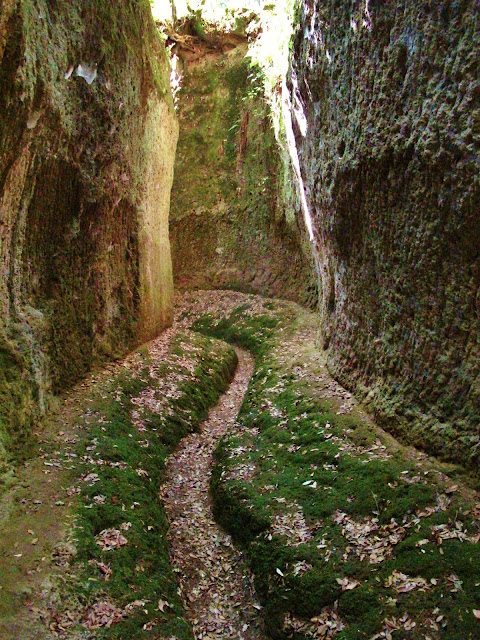The Etruscan civilization is a mystery to historians and archeologists alike. Some of the baffling remnants of their culture are the subterranean roads called the Vie Cave, or the 'Sunken Roadways' are 'Streets of The Dead' leading to ancient necropoli...

There are ancient excavated roadways all across Spain,
Italy, Turkey and into the Middle East in as far away places such as Isreal and
Jordan. The "roads" were constructed by different civilizations
and for various purposes. In Jordan, for example, channels were carved into the
rock to direct water to ancient cisterns.
In Southern Tuscany, these excavated or "sunken" roads are
called Cavoni or also Vie Cave. These
pathways were hand chiselled into the volcanic tufo rock, and are much older
than once thought by archeologists.
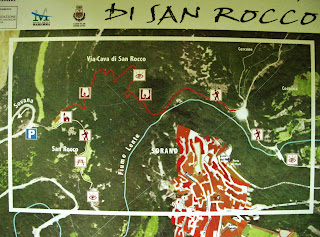
The Vie Cave are called 'Tagliate Etrusche' or 'Etruscan Cuts' by the locals and is attributed to being carved by the ancient Etruscans. They are now thought to have been constructed by the Iron-Age Villianovian Civilization, the earliest of the Etruscans. The Villianovians lived in Southern Tuscany and Umbria in about 900-700 BCE. However, the Vie Cave could be much older than that. Much speculation on what the purpose of the Vie Cave was; for directing rainwater into cisterns, as defensive measures against attack o. perhaps, for ceremonial purposes. The Romans later incorporated the Vie Cave into their roads system to form part of the Via Clodia that linked Rome with Manciano in Tuscany, which was a vital farming region for the Empire.
These trails that were hand-carved into the rock are commonly known in Italian as 'Vie Sacre' or 'Sacred Pathways.' Many of the Vie Cave lead from village centres to Etruscan Necroploi or "cities of the dead." There is a theory that the dead were not transported above ground; instead, they were carried through the subterranean Vie Cave to a Necropolis for cremation and burial. Through the centuries, Early Christians left religious symbols on the Vie Cave. Christian symbols were also carved into the Etruscan tombs, and many early churches were built alongside the Vie Cave.
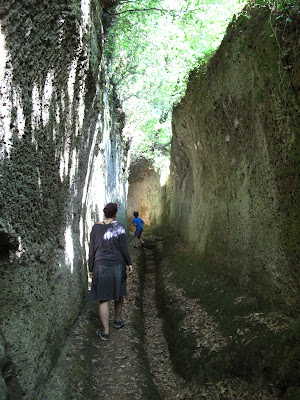
Hiking trails in Southern Tuscany are plentiful, with day-long and multi-day journies through every type of terrain. There are around 15 Vie Cave in the Southern Tuscan area linking the hill-top towns of Pitigliano, Sovana, Sorano, San Quirico, the lost city of Vitozza and San Valentino with its ghost town. Hiking a shady Via Cava (singular for Vie Cave) is a pleasant and refreshing walk in the heat of the afternoon Tuscan sun. The Vie Cave canyons can get up to 20 meters deep and up to 3 meters wide, typically following a river bed. Take great caution when walking the Vie Cave, for they are on the World Heritage Watch List for endangered monuments because of their fragile nature. The rock is so soft and easily eroded by water and flooding. Look for the ancient chisel marks of the Etruscan carvers still visible in the Via Cava stone almost three thousand years later!
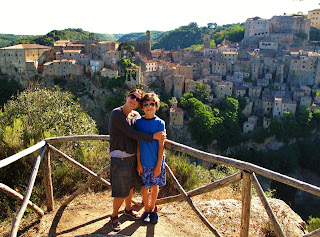
I discovered the Vie Cave when exploring the Southern Tuscan village of Sorano. After spending the night in a Medieval castle high above Sorano, we were driving to the natural hot springs in Saturnia. Travelling along the SP22 regional road, we saw a roadside viewpoint about 2 km outside of Sorano. Here, you will find a gorgeous view of Sorano across the Lente River canyon. This was also the trailhead for the San Rocco Via Cava that descends slowly down to the Lente River, winds around the base of Sorano and ends in Vitozza about a 3 hours walk away.

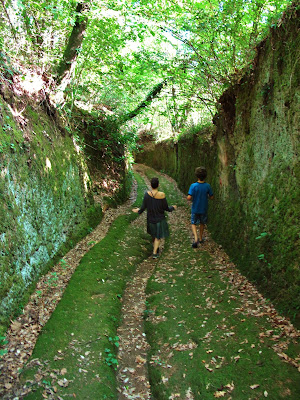
There are surprises to discover at every twist and turn
along the San Rocco Via Cava, including many caves, cliffs and necropoli!
Have you walked any Vie Cave; which one? I would love to hear about your experience in
the comments below!
